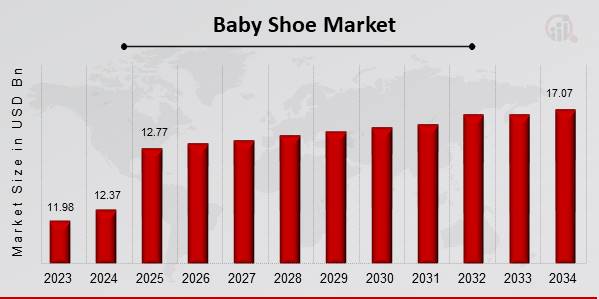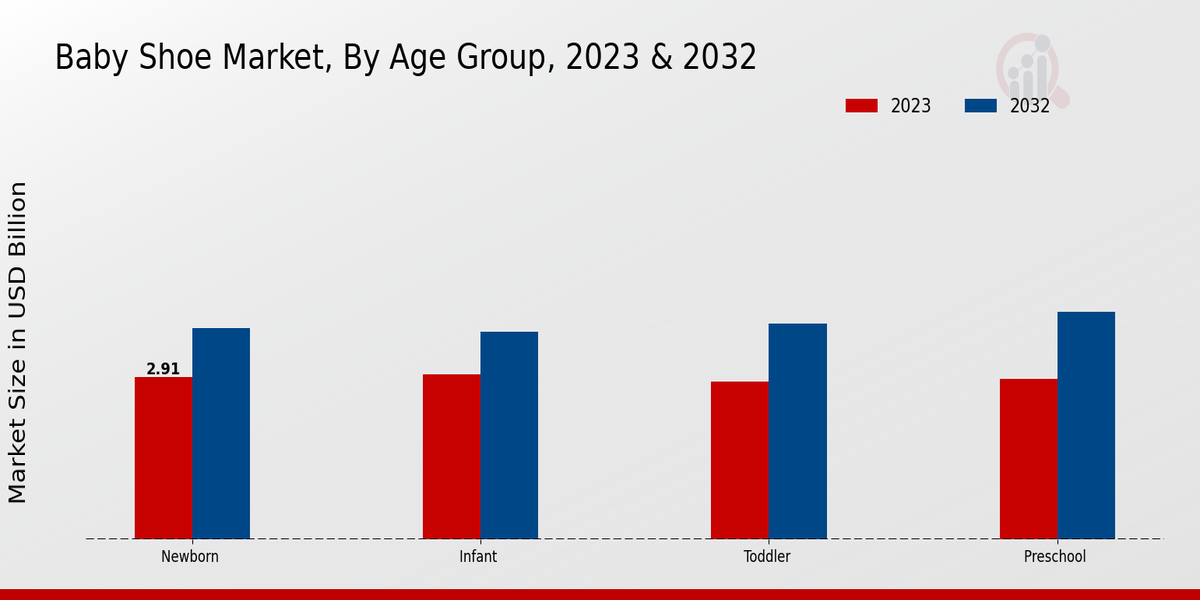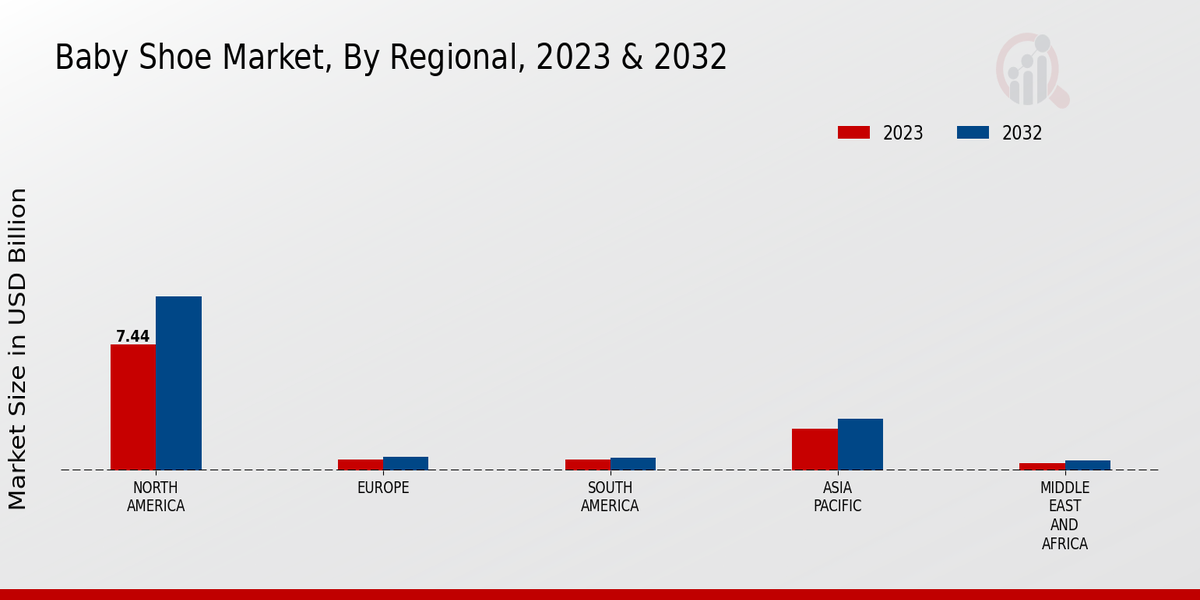Global Baby Shoe Market Overview
Baby Shoe Market Size was estimated at 12.37 (USD Billion) in 2024. The Baby Shoe Market Industry is expected to grow from 12.77 (USD Billion) in 2025 to 17.07 (USD Billion) by 2034. The Baby Shoe Market CAGR (growth rate) is expected to be around 3.3% during the forecast period (2025 - 2034).

Source Primary Research, Secondary Research, MRFR Database and Analyst Review
Key Baby Shoe Market Trends Highlighted
As new materials and design trends are being adopted, this is also causing shifts in the baby shoe market. Eco-friendly materials, soft cooling clothes, and non-slip soles are in demand as more parents focus on comfort, safety, and eco-friendliness. Customization and personalization are also growing, as parents want different shapes and styles for their children.
Emerging technologies are also adding value as well to the market. Smart shoes with the ability to monitor where the baby is and what they are doing help track the baby's progress, whereas shoes can now be designed and printed using 3D printer technology. Baby shoe retailers are tapping into online marketplaces, whereas social media is serving as an effective and interactive platform for the brands.
With more parents becoming health conscious, there is increasing demand for ergonomic and orthopedic baby shoes. There is growing acceptance of shoes that are made to ensure that baby feet are well developed and prevent any future orthopedic problems. Other trends, such as athleisure and other outdoor activities, are also affecting the construction of baby shoes as more shoes have sport- and adventure-centric designs.
Baby Shoe Market Drivers
Rising Demand for Comfortable and Stylish Footwear
Parents are increasingly prioritizing the comfort and well-being of their babies, driving the demand for baby shoes that provide optimal support and protection for delicate feet. Furthermore, the growing fashion consciousness among parents has led to a surge in demand for stylish and aesthetically pleasing baby shoes that complement various outfits and occasions. The Baby Shoe Market Industry has witnessed a significant rise in the popularity of designer and branded baby shoes, catering to the desire for premium and exclusive footwear for infants.
Growing Awareness of Foot Health in Early Childhood
More and more medical professionals and parents are now conscious that the correct development of the feet during early childhood is an urgent issue. Shoes for babies are essential to guarantee the protective growth and alignment of feet. Indeed, flat feet or bunions may appear later on if the child does not wear proper shoes at the early stages of life. The Baby Shoe Market Industry has adequately responded to this increasing awareness, providing a great variety of models, all conceived to properly assist the natural development of baby feet, thereby encouraging the right posture and balance.
Expansion of E-commerce and Online Retail
The rapid growth of e-commerce has revolutionized the baby shoe market, making it more convenient and accessible for parents to purchase footwear for their little ones. Online retailers offer a vast selection of baby shoes from various brands and styles, allowing parents to compare prices and find the best deals. The convenience of online shopping has contributed to the increasing popularity of baby shoes purchased through e-commerce platforms, expanding the reach of the Baby Shoe Market Industry.
Baby Shoe Market Segment Insights
Baby Shoe Market Age Group Insights
The Baby Shoe Market segmentation by Age Group offers valuable insights into the market dynamics and consumer preferences. The Newborn (0-6 months) segment is expected to witness steady growth over the forecast period due to the increasing birth rate and rising disposable income of parents. In 2023, this segment accounted for a significant share of the Baby Shoe Market revenue, and it is projected to maintain its dominance in the coming years. The Infant (6-12 months) segment is another key contributor to the market growth, driven by factors such as increased awareness about baby foot health and the availability of a wide range of stylish and comfortable footwear options.The Toddler (1-3 years) segment is witnessing a surge in demand as parents become more conscious about their child's foot development and prefer shoes that provide both protection and support. This segment is expected to grow at a CAGR of over 4.5% during the forecast period, driven by the increasing popularity of active lifestyles and the growing number of daycare centers and preschools. The Preschool (3-5 years) segment is also expected to contribute to the overall market growth, as children in this age group are more active and require durable and comfortable footwear that can keep up with their growing feet.Overall, the Age Group segmentation provides a comprehensive understanding of the Baby Shoe Market dynamics and helps identify target customer groups for effective marketing strategies. Manufacturers can leverage these insights to develop products that meet the specific needs and preferences of each age group, thus driving market growth and profitability.

Source Primary Research, Secondary Research, MRFR Database and Analyst Review
Baby Shoe Market Material Type Insights
The Baby Shoe Market segmentation by Material Type includes Leather, Canvas, Rubber, EVA (Ethylene-Vinyl Acetate), and Synthetic Leather. Leather holds the largest market share due to its durability, comfort, and breathability. Canvas is a popular choice for summer shoes as it is lightweight and breathable. Rubber is used for its water resistance and durability, making it ideal for outdoor activities. EVA is a lightweight and flexible material that provides cushioning and support. Synthetic leather is a cost-effective alternative to leather that offers similar properties.
Baby Shoe Market Design Type Insights
Design Type Segment Insights and Overview In the Baby Shoe Market, segmentation by design type plays a pivotal role in understanding the preferences and needs of consumers. The market comprises a diverse range of design types, each catering to specific needs and age groups. Key design types include booties, slip-ons, lace-ups, Velcro straps, and sandals. Booties, designed for infants and toddlers, offer warmth and comfort with their enclosed design. Their popularity has been attributed to their ease of use and adorable appeal, contributing to their significant market share.Slip-ons, also known as moccasins, are convenient and practical, making them a popular choice for toddlers and preschoolers. Their slip-on design allows for quick and easy wearability, adding to their appeal. Lace-ups are primarily designed for older toddlers and children, offering a more secure and adjustable fit. They provide stability and support, making them suitable for active play and outdoor activities. Velcro straps, on the other hand, offer a customizable and convenient option, allowing for easy adjustment and a snug fit. They are particularly popular among parents who seek a balance between comfort and security.Sandals, designed for warm weather and outdoor activities, feature an open design for breathability and comfort. Their versatility makes them a preferred choice for toddlers and preschoolers who engage in various activities. The Baby Shoe Market revenue generated by sandals is expected to witness steady growth due to increasing outdoor activities and the rising popularity of comfortable footwear options.
Baby Shoe Market Sole Type Insights
The Baby Shoe Market is segmented by Sole Type into Soft Sole, Hard Sole, Flexible Sole, and Non-Slip Sole. The Soft Sole segment is expected to hold the largest market share in 2023, accounting for 42.1% of the market. It is driven by the increasing demand for comfortable and flexible footwear for infants and toddlers. The Hard Sole segment is projected to grow at the highest CAGR of 4.1% during the forecast period from 2024 to 2032. This growth is attributed to the rising popularity of durable and supportive footwear for older babies and toddlers who are learning to walk.The Flexible Sole segment is expected to account for a significant market share of 29.3% in 2023, owing to its ability to provide both comfort and flexibility. The Non-Slip Sole segment is also projected to witness steady growth during the forecast period, driven by the growing demand for safe and secure footwear for babies and toddlers.
Baby Shoe Market Features Insights
The Features segment of the Baby Shoe Market is expected to witness significant growth in the coming years. Key features such as Breathable, Antimicrobial, Waterproof, Adjustable Fit, and Machine Washable are driving the segment's growth. Breathable baby shoes allow air to circulate, keeping the baby's feet cool and dry. This is important for preventing foot odor and discomfort. Antimicrobial baby shoes help to protect the baby's feet from bacteria and fungi. This is important for preventing infections. Waterproof baby shoes keep the baby's feet dry in wet weather.This is important for preventing blisters and other foot problems. Adjustable Fit baby shoes can be adjusted to fit the baby's foot as it grows. This is important for ensuring a comfortable fit. Machine Washable baby shoes can be easily cleaned in the washing machine. This is important for busy parents who don't have time to hand-wash their baby's shoes.
Baby Shoe Market Regional Insights
Regionally, North America is expected to dominate the market, accounting for 38.5% of the market share in 2023. The region's high disposable income and growing awareness about baby care products are key factors driving the market growth. Europe holds the second-largest market share, followed by the Asia Pacific region, which is anticipated to exhibit the highest CAGR during the forecast period. The increasing birth rates and urbanization in APAC are major contributors to the market's expansion. South America and the Middle East Africa (MEA) are expected to grow steadily, driven by the rising demand for baby products and the expansion of retail channels.

Source Primary Research, Secondary Research, MRFR Database and Analyst Review
Baby Shoe Market Key Players And Competitive Insights
Major players in the Baby Shoe Market industry are constantly striving to gain a competitive edge by investing in research and development, expanding their product portfolios, and forming strategic partnerships. Leading Baby Shoe Market players are focusing on innovation and product differentiation to cater to the evolving needs of consumers. They are also adopting sustainable practices and ethical sourcing to align with the growing consumer demand for eco-friendly products. The competitive landscape of the Baby Shoe Market is expected to witness further consolidation as key players seek to strengthen their market positions through acquisitions and mergers.A leading company in the Baby Shoe Market industry is Carter's, which has a strong brand reputation and a wide product portfolio that includes baby shoes, clothing, and accessories. Carter's leverages its extensive distribution network to reach a customer base. The company emphasizes product quality, safety, and comfort, and it adheres to strict ethical sourcing practices. Carter's also invests in customer service and offers a loyalty program to foster customer loyalty.A notable competitor in the Baby Shoe Market is Stride Rite, which specializes in high-quality children's footwear. Stride Rite focuses on providing shoes that support proper foot development and comfort for children of all ages. The company employs podiatrists and other experts to design shoes that meet the specific needs of growing feet. Stride Rite has a strong brand presence in the United States and is expanding its reach through strategic partnerships and retail expansion.
Key Companies in the Baby Shoe Market Include
- Converse
- PUMA
- DIADORA
- New Balance
- Carter's
- Belle
- NIKE
- Skechers
- OshKosh B'Gosh
- Li Ning
- Under Armour
- Peak
- Adidas
- ASICS
Baby Shoe Market Industry Developments
The baby shoe market is projected to reach USD 15.5 billion by 2032, exhibiting a CAGR of 3.27% during the forecast period. Rising disposable income, increasing birth rates, and growing awareness of infant foot health are driving market growth. Asia-Pacific is expected to hold the largest market share due to the presence of a large population base and increasing urbanization. Key industry players are focusing on product innovation and sustainability initiatives to cater to changing consumer preferences. Recent developments include the launch of eco-friendly baby shoes made from recycled materials and the integration of smart technology for monitoring infant foot development.
Baby Shoe Market Segmentation Insights
Baby Shoe Market Age Group Outlook
- Newborn (0-6 months)
- Infant (6-12 months)
- Toddler (1-3 years)
- Preschool (3-5 years)
Baby Shoe Market Material Type Outlook
- Leather
- Canvas
- Rubber
- EVA (Ethylene-Vinyl Acetate)
- Synthetic Leather
Baby Shoe Market Design Type Outlook
- Booties
- Slip-ons
- Lace-ups
- Velcro Straps
- Sandals
Baby Shoe Market Sole Type Outlook
- Soft Sole
- Hard Sole
- Flexible Sole
- Non-Slip Sole
Baby Shoe Market Features Outlook
- Breathable
- Antimicrobial
- Waterproof
- Adjustable Fit
- Machine Washable
Baby Shoe Market Regional Outlook
-
North America
-
Europe
-
South America
-
Asia Pacific
-
Middle East and Africa
| Report Attribute/Metric |
Details |
| Market Size 2024 |
12.37 (USD Billion) |
| Market Size 2025 |
12.77 (USD Billion) |
| Market Size 2034 |
17.07 (USD Billion) |
| Compound Annual Growth Rate (CAGR) |
3.3% (2025 - 2034) |
| Report Coverage |
Revenue Forecast, Competitive Landscape, Growth Factors, and Trends |
| Base Year |
2024 |
| Market Forecast Period |
2025 - 2034 |
| Historical Data |
2019 - 2023 |
| Market Forecast Units |
USD Billion |
| Key Companies Profiled |
Converse, PUMA, DIADORA, New Balance, Carter's, Belle, NIKE, Skechers, OshKosh B'Gosh, Li Ning, Under Armour, Peak, Adidas, ASICS |
| Segments Covered |
Age Group, Material Type, Design Type, Sole Type, Features, Regional |
| Key Market Opportunities |
Technological advancements in manufacturing Increased demand for eco-friendly footwear Growing disposable income in developing economies Rise of online retail platforms Focus on comfort and style |
| Key Market Dynamics |
Rising disposable income Growing awareness of baby footwear Increasing number of working parents Technological advancements Ecommerce expansion |
| Countries Covered |
North America, Europe, APAC, South America, MEA |
Frequently Asked Questions (FAQ) :
The baby shoe market was valued at approximately USD 11.98 billion in 2023 and is projected to reach USD 17.07 billion by 2034, exhibiting a CAGR of 3.3% during the forecast period.
Asia Pacific is the dominant region in the baby shoe market, accounting for over 40% of the market share in 2023. The region's large population base, rising disposable income, and growing awareness of baby care products are key factors driving its dominance.
The baby shoe market is primarily driven by the increasing birth rate, rising disposable income, and growing awareness of infant health and well-being. Additionally, the increasing popularity of online shopping and the availability of a wide range of baby shoe styles and designs are contributing to market growth.
Key competitors in the baby shoe market include Nike, Adidas, Puma, Skechers, Under Armour, Carter's, OshKosh B'Gosh, Stride Rite, and Geox. These companies offer a wide range of baby shoe styles and designs to meet the diverse needs of consumers.
The major application segments in the baby shoe market include casual wear, sports wear, and special occasion wear. Casual wear holds the largest market share due to the increasing demand for comfortable and stylish shoes for everyday use.
Key trends shaping the baby shoe market include the growing popularity of sustainable and eco-friendly materials, the increasing adoption of smart baby shoes with tracking and monitoring capabilities, and the rising demand for personalized and customized baby shoes.
The baby shoe market is projected to exhibit a CAGR of 3.3% during the forecast period from 2025 to 2034.
Factors that could potentially restrain the growth of the baby shoe market include economic downturns, fluctuations in raw material prices, and increasing competition from low-cost manufacturers.
Key opportunities for growth in the baby shoe market include the expansion into emerging markets, the development of innovative and technologically advanced baby shoes, and the growing popularity of online shopping.
Major challenges faced by players in the baby shoe market include intense competition, changing consumer preferences, and the need to comply with stringent safety and quality regulations.

















